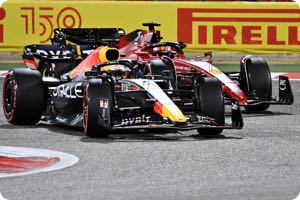DECEMBER 31, 2022
The devil is in the details
Although it was Ferrari that led the way in the first third of the championship, Red Bull always had a very quick car right from the Bahrain Grand Prix and it was only reliability that robbed Max Verstappen of second places in the inaugural Grand Prix and one month later in Melbourne, the two DNF’s split by a thrilling victory in Saudi Arabia, where he beat Charles Leclerc after an exciting battle.
Although it was Ferrari that led the way in the first third of the championship, Red Bull always had a very quick car right from the Bahrain Grand Prix and it was only reliability that robbed Max Verstappen of second places in the inaugural Grand Prix and one month later in Melbourne, the two DNF’s split by a thrilling victory in Saudi Arabia, where he beat Charles Leclerc after an exciting battle.
What the Red Bull RB18 was missing, initially, was a strong front end that would suit Max Verstappen’s very particular style and while there was too much understeer for the Dutchman’s liking, Sérgio Pérez was surprisingly close to his pace, as the characteristics of the chassis were playing right into his driving style.
You see, like Michael Schumacher and Kimi Raikkonen, Verstappen wants his car’s front end to have tremendous grip, so it rotates exactly as much as he turns the steering wheel, with minimum or no understeer into it. That, of course, makes the rear end of the car very nervous, but those three champions reckoned, with good reason, they could handle that with enough steering and throttle inputs, in what was - and is for young Max - the faster set-up for them.
By the French Grand Prix Red Bull had addressed the issue, making important changes to the front of the RB18 to make it “pointy” and it was from the Paul Ricard onwards that Verstappen essentially dominated the procedures.
Not surprisingly, Pérez’s season floundered, as he couldn’t cope with the new characteristics of the car and in his attempts to drive against his instincts he started to suffer massive front tyre degradation, so the man known as “the tyre whisperer” for his great tyre management, started to use up his rubber way faster than Verstappen - while also going a bit slower…
Of course getting the initial concept of the car for this year’s brand-new Technical Regulations was the key and what Red Bull tried to keep away from its rivals was that more than the shape of the sidepods - a subject of great discussion right from the start of the year with three different concepts in evidence - it was getting the rear of the car to have considerable higher ride than the front that was the key to generate maximum downforce from the diffuser.
That concept came from none other than the genial Adrian Newey, who on top of fulfilling his role as Chief Technical Officer, decided he was going to design the gearbox casing and determine the rear suspension pick up points of the RB18.
Those, of course, were placed higher up than in any other 2022-spec car and being a part teams cannot easily redesign during the year - for production times are way too long. It was a feature no one could copy this year, giving Red Bull a decisive advantage over its rivals.
Mercedes, who dominated in previous years, was the biggest loser of this change of regulations, as even with a pole position in Hungary and a 1-2 win in Brazil, it was clear the W13 never worked as the team was expecting.
Trial and error were very much the method used by Mike Elliot and his group to try and find a way forward, before they reached, before the summer break, that the issue was not the aerodynamic concept but the structural rigidity of the car’s floor.
By going for the sidepod zero concept, Mercedes wanted to explore the free area around the side of the cars to redirect the airflow into the top of the diffuser and gain maximum downforce. But having such big pieces of carbon fiber with no more than the allowed one stay to keep them stable, backfired, for at speed the edges of the floor would inevitably start to flex, causing the dreaded porpoising effect, while also changing the aerodynamic characteristics of the car, both on the underside of the floor - with reduced power sent to the diffuser - and to the upper surface - a lose/lose situation that could not be fixed for this year.
Next year’s W14 will feature bigger sidepods, only because the floor edges need a stronger structure to make sure they don’t flex as much, but that will come with a change in the upper surfaces aerodynamics characteristics, plus an alteration of the weight distribution and the center of gravity, as mechanical and cooling parts will be moved around to make the most out of the bigger space available to them.
